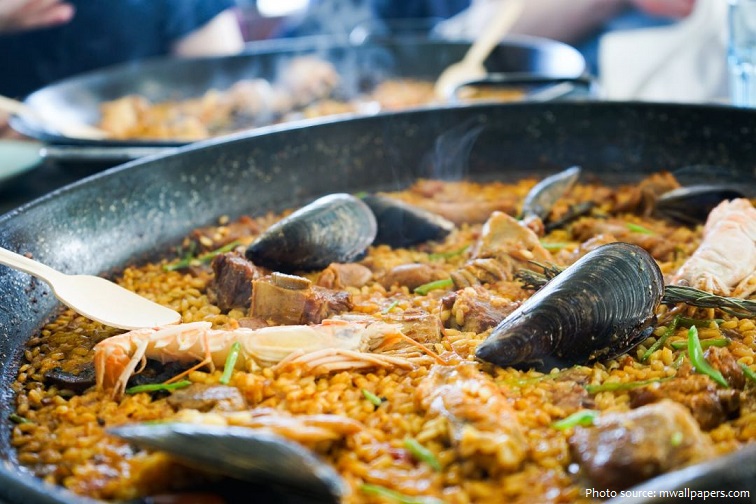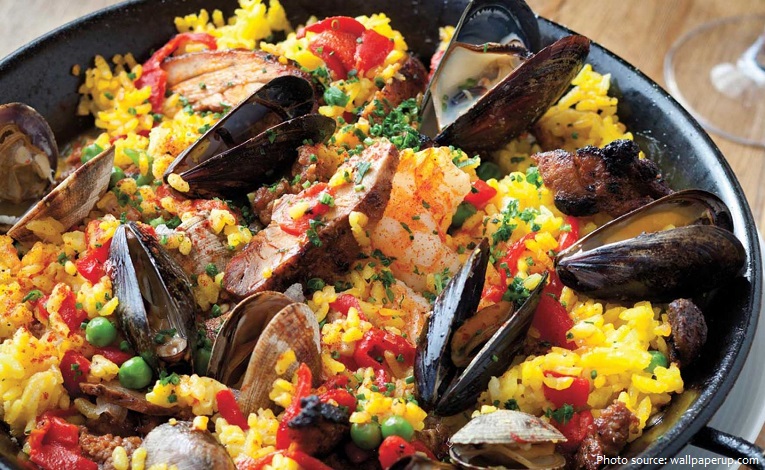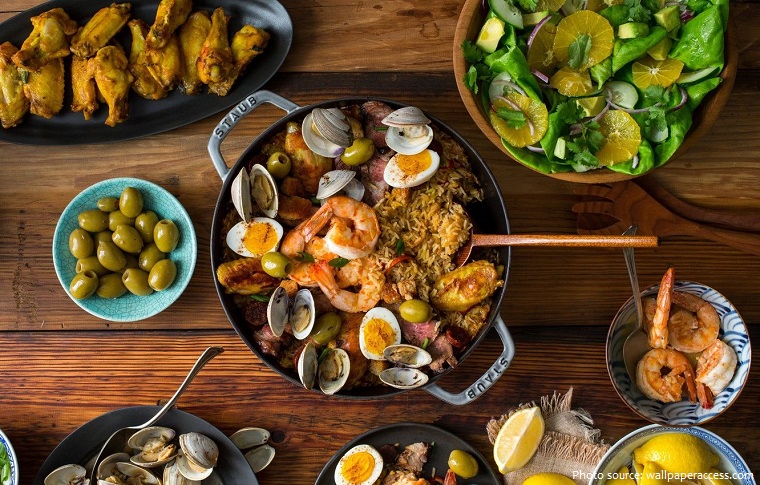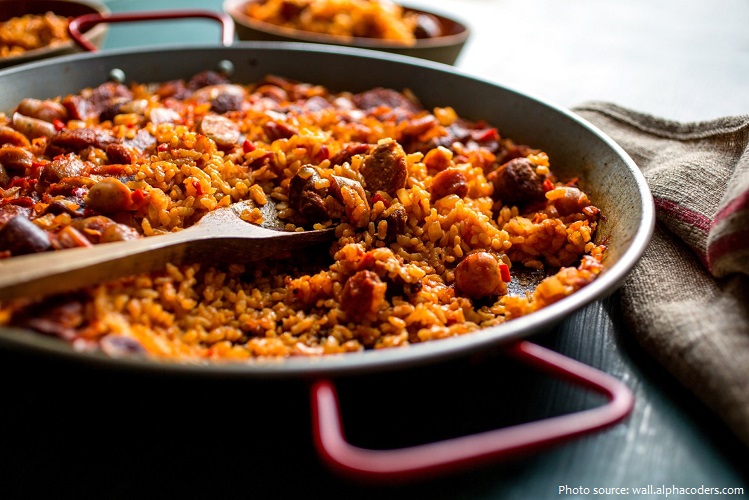
Paella is a rice dish originally from Valencia.
It is one of the best-known dishes in Spanish cuisine. For this reason, many non-Spaniards view it as Spain’s national dish, but Spaniards almost unanimously consider it to be a dish from the Valencian region. Valencians, in turn, regard paella as one of their identifying symbols.
The dish takes its name from the wide, shallow traditional pan used to cook the dish on an open fire, paella being the word for a frying pan in Valencia’s regional language.

There are several version of the dish.
Paella valenciana is the traditional paella of the Valencia region, believed to be the original recipe, and consists of round grain rice, bajoqueta and tavella (varieties of green beans), peas, rabbit, chicken, sometimes duck and garrofó (a variety of lima or butter bean) cooked in olive oil and chicken broth. The dish is (sometimes) seasoned with whole rosemary branches. Traditionally, the yellow color comes from saffron, but turmeric and calendula can be used as substitutes. Artichoke hearts and stems may be used as seasonal ingredients. Most paella cooks use bomba rice, but Valencians tend to use a cultivar known as senia.
Paella de marisco (seafood paella) replaces meat with seafood and omits beans and green vegetables, while paella mixta (mixed paella) combines meat from livestock, seafood, vegetables, and sometimes beans, with the traditional rice.

Other popular local variations of paella are cooked all through the Mediterranean area, the rest of Spain and internationally.
There is an old story of how the Moorish kings’ servants created rice dishes by mixing the left-overs from royal banquets in large pots to take home. Some say that that word paella originates from the Arab word “baqiyah” meaning left-overs. However, linguists believe that the word paella comes from the name of the pan it is made in—the Latin term patella, a flat plate on which offerings were made to the Gods.
Originally, paella made in Valencia was a lunchtime meal for farmers and farm laborers. Workers would gather what was available to them around the rice fields. This often included tomatoes, onions, and snails. Rabbit or duck was a common addition, or chicken less often.

On special occasions, 18th century Valencians used calderos to cook the rice in the open air of their orchards near lake Albufera. Water vole meat was one of the main ingredients of early paellas, along with eel and butter beans. Novelist Vicente Blasco Ibáñez described the Valencia custom of eating water voles in Cañas y Barro (1902), a realistic novel about life among the fishermen and peasants near lake Albufera.
Paella’s modern form is traced back to the mid-19th century, in the rural area around the Albufera lagoon adjacent to Valencia, on the east coast of Spain.
Living standards rose with the sociological changes of the late 19th century in Spain, giving rise to gatherings and outings in the countryside. This led to a change in paella’s ingredients, as well, using instead rabbit, chicken, duck and sometimes snails. This dish became so popular that in 1840, a local Spanish newspaper first used the word paella to refer to the recipe rather than the pan.

During the 20th century, paella’s popularity spread past Spain’s borders. As other cultures set out to make paella, the dish invariably acquired regional influences. Consequently, paella recipes went from being relatively simple to including a wide variety of seafood, meat, sausage (including chorizo), vegetables and many different seasonings. However, the most globally popular recipe is seafood paella.
One of the most important components in the preparation of the dish is, of course, the ‘paella’ or pan itself, which is typically large (sometimes huge), round and thin-based. Nowadays, paella dishes come in all sorts of different materials and shapes to adapt to the needs of modern kitchens. The early paella dishes and more traditional ones these days are slightly convex, not flat-bottomed, which is believed to help with the preparation of one of the first stages of the dish: the sofregit, or sofrito in Spanish, (see below). Because paella would traditionally have been cooked over an open fire, the question of heat distribution on a convex pan would not have been a problem in the same way as it would be with today’s induction and electric hobs.

Before cooking in a paella pan, be sure to season the pan. Although there are different ways to do this, the simplest method is to first wash the pan with warm water and soap and dry with a soft cloth immediately. While the pan is still warm, using a soft cloth or paper towel, rub olive oil over the entire inside of the pan. If the pan is not warm after washing, place it in the oven on warm for a few minutes, then rub the oil on it.
Fresh ingredients of good quality are of prime importance when preparing to cook paella, but perhaps above the importance of those ingredients is the choice of rice. In order for the rice to do what is expected of it in the course of the preparation of the dish, it needs to be short-grained, slightly rounded, able to absorb liquid but also retain a certain firmness in cooking. There is nothing more likely to ruin an otherwise delicious paella than a mushy rice.
The largest paella measured 20 m (65 ft and 7 in) in diameter and was made by Juan Carlos Galbis and a team of helpers in Valencia, Spain on 8 Mar 1992. It was eaten by 100,000 people.